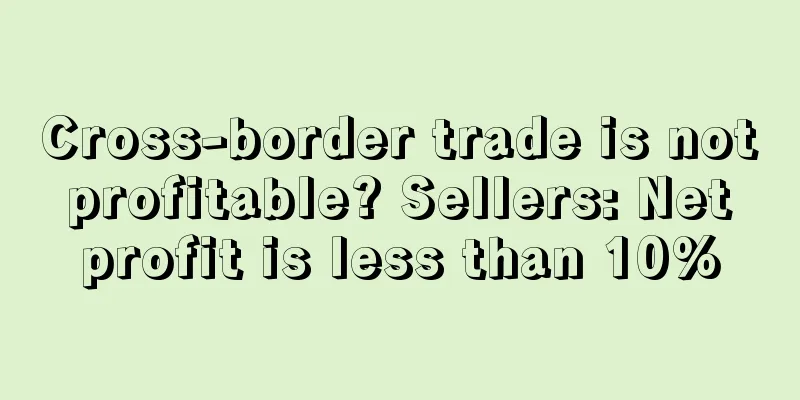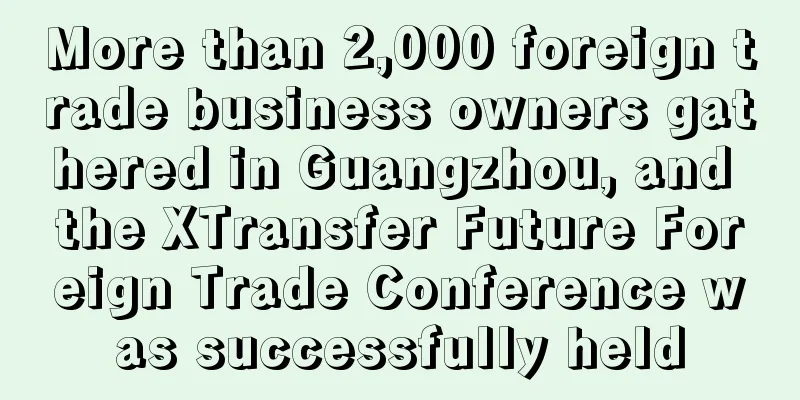Cross-border trade is not profitable? Sellers: Net profit is less than 10%

|
What is the profit situation of cross-border e-commerce sellers?
The first goal of most cross-border traders is to make money, so the question is, what is the average annual profit margin of cross-border sellers? Many people in the industry share their experiences.
Cross-border business is not profitable? Sellers: The annual net profit is about 10 points
How much money can cross-border e-commerce earn each year? It can be observed that the actual situation of each cross-border company is different:
Forget about making money, many of my colleagues are losing money. Last year's sales were 50 million and the net profit was only 5% . The company mainly produces low-priced products, with annual sales of 400 million and a net profit of about 10%. I worked hard for a year but didn't see any money. All the earnings were used to buy goods. The German site is very competitive this year, product prices are kept very low, but costs are rising. From what I have personally learned, the net profit of large companies around me is 7-10% , and that of small companies is 10-15% . …
The seller Xiao Zhang said that the net profit of the entire company is 10% . The annual sales can reach 100 million yuan. After deducting all costs such as labor, water and electricity, the net profit is not much. There are many expenses incurred during the specific operation process, such as advertising fees and storage fees.
Coincidentally, seller Xiao Li also said that he expected a full-year net profit of 10 points. Xiao Li is a solo seller who officially started his business in 2021. He mainly sells high-quality products with relatively few SKUs. He did not save much money in 2022 and 2023, and only started to see cash flow this year.
According to feedback, the full-year net profit of many cross-border e-commerce companies is 10 percentage points. Some large companies that focus on brands have higher net profits because of brand premiums, but some sellers also said that the full-year net profit is less than 10 percentage points.
Seller Xiao Liu is one of those with a net profit of less than 10 points. His company mainly sells large products. Due to the fierce market competition this year, product advertising and promotion expenses have remained high, and advertising expenses basically account for 20% of the total cost. Coupled with many other cost expenditures, the net profit can only be maintained at around 7%.
There are many people in the same situation as Xiao Liu. As cross-border e-commerce becomes more and more popular, a large number of sellers have found that their net profits will decline slightly every year.
Xiao Zhou detailed that compared with last year, the average net sales cost increased from 43% to 62% . Although the cost expenditure increased significantly, the product sales volume decreased year by year. As a result, the net profit this year will decrease again. "Compared with previous years, this year is definitely the worst year. Next year, we will not seek to make a lot of money, but our primary goal is to survive."
"I have worked hard for a year but have not seen any profit. It will be a great thing if I can finish selling the inventory this year." Another Amazon seller said that he took over a store at the beginning of this year and has not made any money for a whole year. Although the store has 5 sales links, 4 links are losing money and only 1 is profitable. On average, the store is losing money. After continuous adjustments, advertising expenditures have been optimized and the number of daily orders is also increasing slightly. I don’t know if it can get rid of the losing state next year.
When talking about the development of cross-border e-commerce in 2025, many sellers are pessimistic.
In the view of many industry insiders, the next e-commerce battlefield will be price, not convenience .
Amazon seller Xiao Li expressed his views in detail: Amazon will be more aggressive in 2025. As a scum seller, I have always believed in this sentence - avoid price wars. Many old sellers know that profit is the most important thing after stepping on the pit. However, some new sellers think that they will first lose money to quickly seize market share, and then slowly increase product prices to pursue profits. However, they don’t know that everyone thinks this way. Cross-border e-commerce can’t continue to do so if they keep losing money.
Sellers on multiple e-commerce platforms are experiencing the baptism of the low-price market. Data shows that Amazon still accounts for 17.9% of online sales in the United States, but Temu's share has climbed to 0.71% . With its low price advantage, Temu is popular in multiple markets, which to a certain extent snatches traffic and customers from the Amazon platform, especially low-price customers, who gradually turn to Temu platform for shopping . For this reason, Amazon had to launch Amazon Haul to resist Temu 's continuous attack.
It's so volume, sellers are using home storage to keep costs down!
"Net profit keeps falling" has become a common saying in the cross-border circle, and a large part of the reason is that the industry is too competitive. An industry insider, "Factory Manager in the Wind", said that everyone's thinking about making products is wrong. After discovering the hot products of their peers , they start to copy and imitate , save materials and lower costs , and then set prices 10% lower , resulting in worse and worse product quality and lower prices. In the end, not only did it hurt the trust of consumers, but sellers were almost all in a state of only shipping but not making money , and sellers, peers, and consumers all suffered.
An important step in making a good product is to explore consumer needs through various channels such as comment sections , carefully develop products , ensure differentiated advantages, and make consumers feel satisfied and continue to shop. In this way, you will have more autonomy in pricing, maintain a normal profit margin, and the company will be able to continue to operate positively.
"This is an idealized state. In real life, many sellers think of the price of the rolls first, rather than the quality of the rolls." Xiao Zhou and other sellers said.
As we all know, storage fees are a considerable expense for cross-border sellers. In order to reduce storage costs, many sellers, especially small and micro sellers, are using home warehouses to reduce costs.
On major social media platforms such as Douyin , you can often see advertisements for "home warehouses" located in cities such as Los Angeles, New York, Philadelphia, and Austin. Operators use their living rooms or garages to process sellers' orders, not only providing delivery services, but also helping sellers discard excess inventory and returns. Even when Amazon sellers' accounts are frozen, some can help re-label Amazon products so that the goods can be shipped back to Amazon warehouses under new listings .
Ms. Li, who immigrated to the United States many years ago , said that most of the current Chinese customers are beginners in the cross-border e-commerce industry . These people cannot afford the cost of cooperating with larger logistics companies , and cannot afford the cost of FBA, because FBA charges 3 times the peak season storage fee , storage utilization surcharge , overage inventory surcharge , warehousing configuration service fee and other fees. In comparison, the charges of home warehouses are much lower, and sellers can save logistics costs. "You may not make a lot of money this way, but as a housewife, I can't find a more suitable job." Ms. Li said.
"Home warehouses are actually a helpless move by small sellers. How can medium and large sellers with scale use this method?" As the business situation of cross-border companies improves, some sellers are able to abandon home warehouses, but many cross-border sellers are deeply bound to home warehouses. A small and micro seller who is using home warehouses said that they prefer to cooperate with family-run warehouses because these warehouses are cheap and willing to handle small batches of goods.
Amazon Platform |
<<: Sales of 62.5 billion in 9 months! Well-known e-commerce platforms are making a lot of money
>>: A dark horse emerges from the red ocean race, and a 1,900 yuan kettle is snapped up
Recommend
Shenzhen cross-border e-commerce giant will be wholly acquired!
For cross-border sellers, 2021 can be described a...
What is Nexus? Nexus Review, Features
<span data-docs-delta="[[20,{"gallery"...
Profit Bandit
Profit Bandit is a product research tool for iOS ...
What is Multi Game Card? Multi Game Card Review, Features
<span data-docs-delta="[[20,{"gallery"...
What is emarketer? emarketer Review, Features
eMarketer is a 93%-owned subsidiary market resear...
Affecting sellers! Domestic cross-border independent station giants are sued by North American counterparts
For enterprises going overseas, independent websi...
Alibaba International Station released the September cross-border index: New overseas consumption concepts are taking shape, and "good enough" makes second-hand mobile phones more attractive than new iPhones
Recently, Alibaba International Station released ...
What is holbilink? holbilink Review, Features
<span data-docs-delta="[[20,{"gallery"...
Amazon has bad news again, sporting goods sellers may be restricted
As the leader of the four major professional spor...
What is MTS Money? MTS Money Review, Features
<span data-docs-delta="[[20,{"gallery"...
Counterattack and rise to the top! OEM factory sprints for IPO
Instead of being controlled by others in the OEM ...
Pampered Chef invests in new technology to enhance its online shopping efforts
Pampered Chef, which sells cookware , kitchen too...
Amazon's eight-digit annual sales are "hijacked" by competitors
Recently, a big seller with eight-figure annual s...
Nearly 1,000 listings have been removed from the shelves! A large number of sellers have been affected
"The more difficult the market is, the more ...
What is Oracle? Oracle Review, Features
Oracle Corporation (Oracle Software Systems Ltd.) ...









